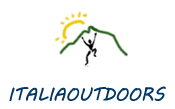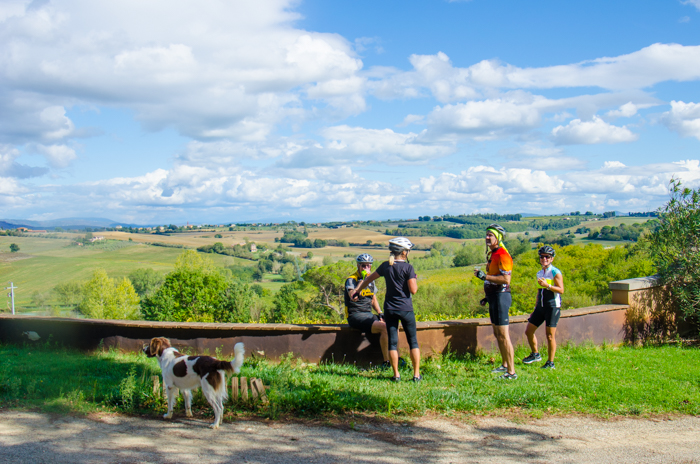
What is a Super Tuscan? A question I am asked often on our Italy tours, be it walking the wine regions in Tuscany, or on a cycling tour. A bit of background to set the stage.
The Italian laws regarding wine production under their DOC (Denominazione di Origine Controllata) system dictate (read my post on Understanding Italian Wines to learn more about this system), among other things, the specific varietals that can be used and origin of the grapes. This system can be quite beneficial to maintaining the quality of great wines, but can also stall progress, restricting some producers to traditional wines made from indigenous grapes according to long-standing, and perhaps outdated techniques. A very frustrating situation for Italian winemakers looking to appeal to an increasing sophisticated international audience.
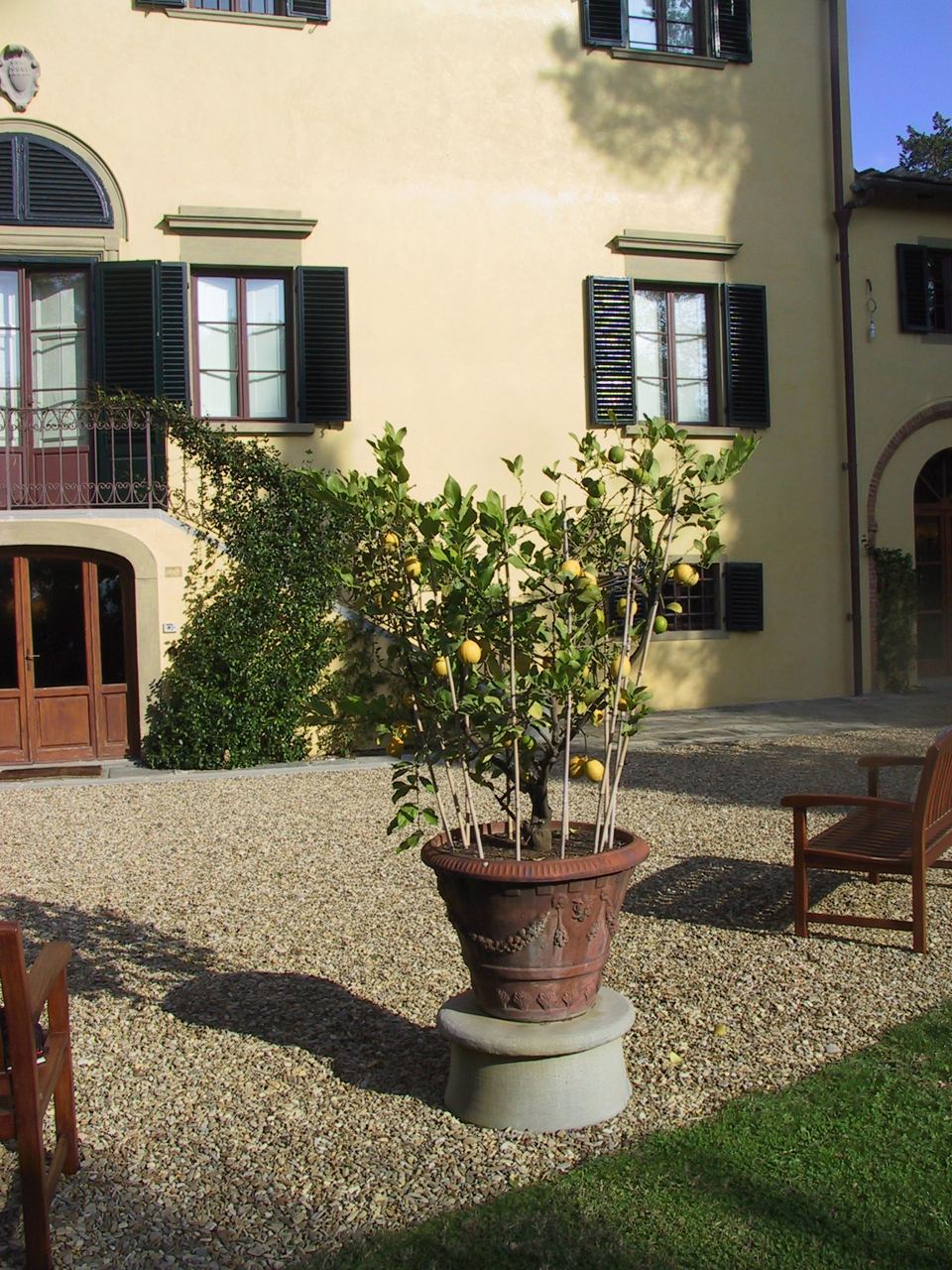
One region stuck in this situation was Chianti Classico. You may recall the old style Chianti bottles wrapped in a straw covered flask, ironically called a fiasco. In the 1970s this was one of Italy’s most highly exported wines, but found itself loosing ground to other more ‘respectable’ wines based on international varietals like Cabernet Sauvignon, Merlot, and Cabernet Franc.
The traditional recipe for a Chianti, dictated by the DOC system. required a large proportion of white grapes - from 10% to as much as 30%. The result was a fruity, thin wine meant to be consumed young, with no ability to age. An increasingly hard sell to a wine-consuming public rapidly moving towards Bordeaux style wines.
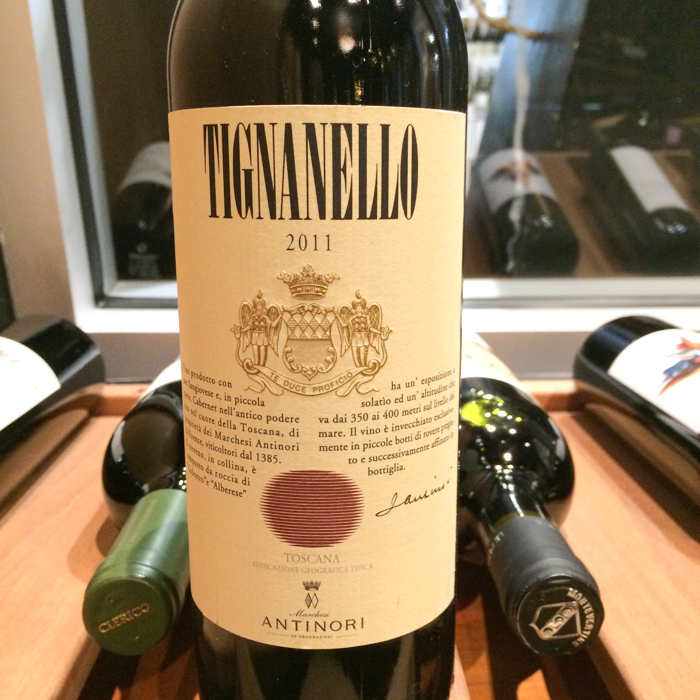
In the early 1970s, Tuscan wine makers, frustrated by the existing system, rebelled, led by the Antinori family. Chianti producer Marchese Antinori released a new wine, Tignanello, in 1974. Instead of the Sangiovese grape, this was a blend of Cabernet Sauvignon and Cabernet Franc from their vineyards in the Chianti region, produced as a Bordeaux style wine, and aged in French oak barrels. Antinori was no doubt inspired by his uncle, Marchesi Incisa della Rocchetta, who since the late 60s had been producing small amounts of a Bordeaux-inspired wine, called Sassicaia (stony ground), in his home in Bolgheri, located near the Tuscan coast in vineyards far from the classic wine producing areas in Tuscany.
In 1978, the Bolgheri area, known prior as a producer of some not very interesting rose and white wine, jumped out of anonymity to garner international attention when the 6-year old Sassicaia beat out an assortment of Bordeaux wines at an international tasting event held by Decanter, a UK wine magazine.
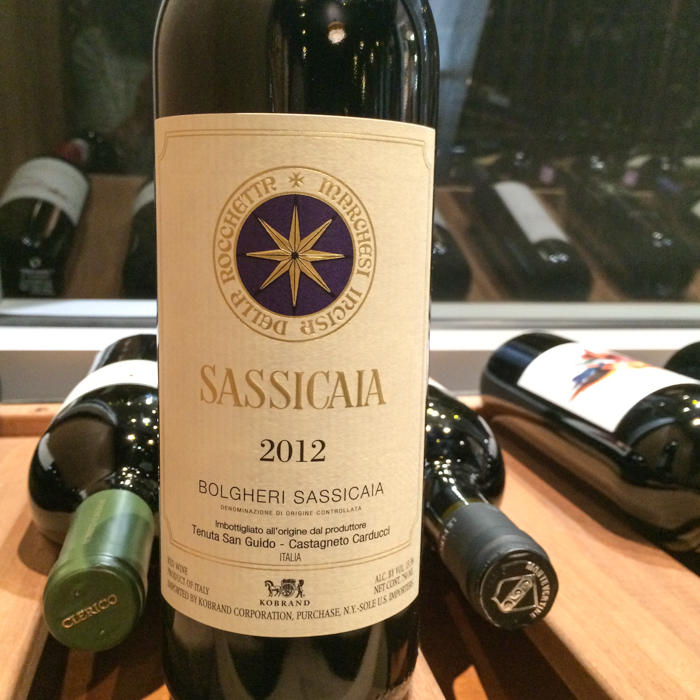
These high quality wines were targeting a commensurate price, but could only be called a Vino di Tavola, sharing this name with the lowest quality Italian table wines. So the term Super Tuscan was adopted, no coincidence in English, to brand these wines, highlighting their superior quality and differentiating them from the lower quality Vino di Tavolo.
As a result of the success of Sassicaia and Tignanello, a groundswell of other Tuscan producers moved to wines based on, or including international grape varieties like Cabernet Sauvignon, Cabernet Franc, Petit Verdot, Merlot, Syrah and others that were not permitted under the DOC. Italian law finally caught up in 1992, when the government introduced the Indicazione Geographica Tipica (IGT) designation. This designation provides deliverance from the restrictions on varietals of the the DOC and the higher-level DOCG. Still considered lower quality than DOC and DOCG, Super Tuscans now often appear under the Toscana IGT designation.
But the revolution made its mark, and today you will find newer DOC appellations bestowed upon the original mavericks. For example, the Bolgheri Sassicaia DOC was created in 1994, for wines from Bolgheri made with a minimum of 80% Cabernet Sauvignon.
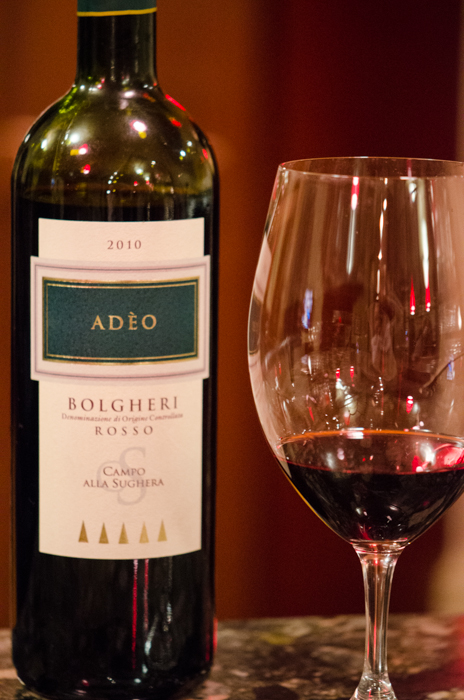
Super Tuscan is essentially a marketing term, not an official designation, originally applied to promote these Bordeaux style wines from Tuscany. It was incredibly successful on that front, with Super Tuscans experiencing great international renown, and commanding high prices. As a result, wine producers in Tuscany began to refer to any wine they might produce that did not follow DOC guidelines as a Super Tuscan, so now you can find Super Tuscans made from 100% Sangiovese. Many of the original acclaimed Super Tuscans, like the aforementioned Sassicaia, are now back in the DOC system. So using term Super Tuscan to describe a wine today gives you very little information, except that it is red, and the grapes - whatever varietal they may be - are predominately from Tuscany.
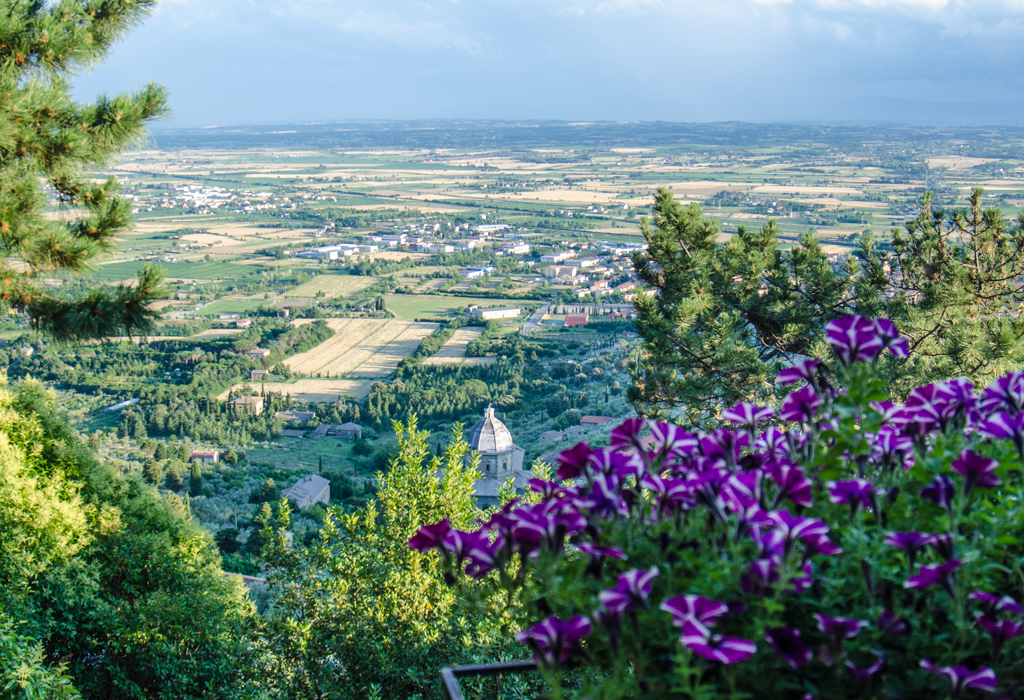 Cortona is a lovely small Tuscan city in the province of Arezzo, its hilltop location offering stunning views of Lake Trasimeno and the Val di Chiana. The vineyards covering the rolling hills surrounding the town belong to the small Cortona DOC wine region. The production area of the Cortona DOC includes all lands devoted to quality grape growing within the Cortona municipality. Vine cultivation is allowed only in fields over 250 m above sea level.
Cortona is a lovely small Tuscan city in the province of Arezzo, its hilltop location offering stunning views of Lake Trasimeno and the Val di Chiana. The vineyards covering the rolling hills surrounding the town belong to the small Cortona DOC wine region. The production area of the Cortona DOC includes all lands devoted to quality grape growing within the Cortona municipality. Vine cultivation is allowed only in fields over 250 m above sea level.
Historical evidence dates the origin of grape cultivation in this area to the Etruscan times when grapes vines were planted amongst orchards, the adjacent trees used to support thee vines. Ancient Etruscan amphorae depict banquet scenes with figures shown drinking wine from goblets. These very same amphorae were likely then used to ferment and transport wine. Writings of the time describe the excellent wines of Etruria, particularly the qualities of a wine called "Estesiaca", produced in the Cortona area. 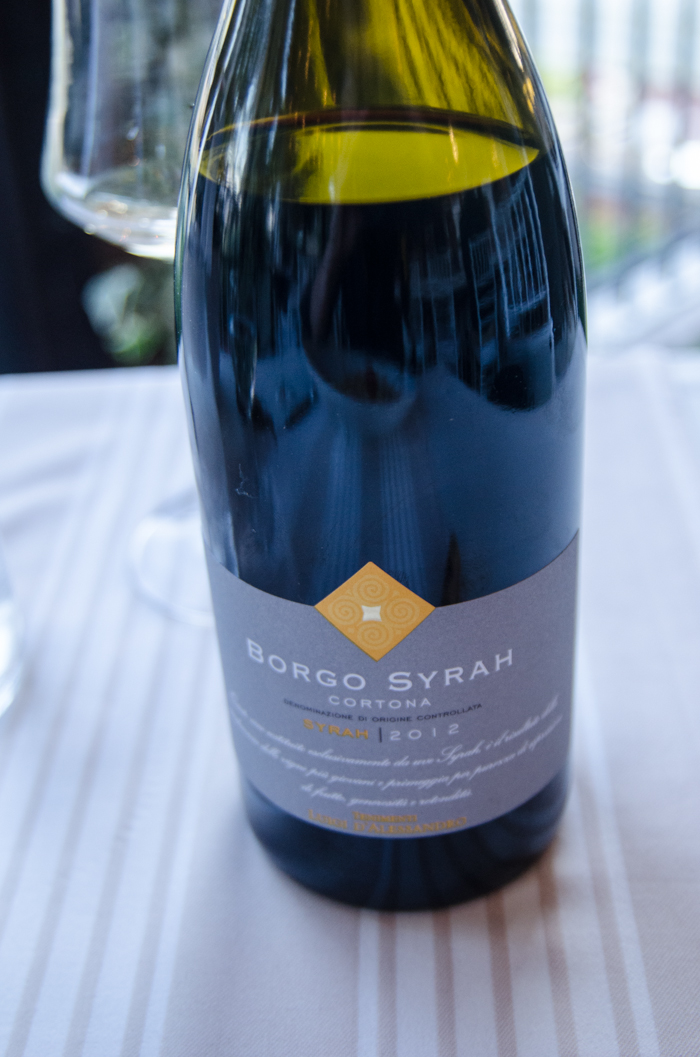 Wine production in the Val di Chiana area suffered in the Middle Ages as the valley deteriorated into swamp. Grape cultivation returned only in the second half of the 16th century when the area was reclaimed, with Cortona wines particularly prized by pope Paul III who during his stays in nearby Perugia had wine delivered from Cortona for his banquets.
Wine production in the Val di Chiana area suffered in the Middle Ages as the valley deteriorated into swamp. Grape cultivation returned only in the second half of the 16th century when the area was reclaimed, with Cortona wines particularly prized by pope Paul III who during his stays in nearby Perugia had wine delivered from Cortona for his banquets.
The wines of the Cortona DOC are listed below. Amongst wines produced from traditional local grapes like Grechetto and Sangiovese, you will see international varietals like Cabernet, Merlot, and, interesingly enough, Syrah, which is not cultivated widely in Italy. During the Napoleonic occupation of this area in early 1800s, the Grand Duke of Tuscany, an avid oenophile, encouraged the cultivation of international varietals here.
Whites:
Cortona Chardonnay
Chardonnay: minimum 85%, with other local white grapes authorized by the DOC, up to a maximum of 15%. Straw yellow in color; fruity scent; dry and harmonious, elegant.
Cortona Grechetto
Grechetto: minimum 85%, with other local white grapes authorized by the DOC, up to a maximum of 15%. Straw yellow in color; fresh, delicate aroma; taste: dry and well-balanced.
Cortona Sauvignon
Sauvignon: minimum 85%, with other local white grapes authorised by the DOC, up to a maximum of 15%. Straw yellow in color; intense, citrus aroma; dry and elegant.
Red: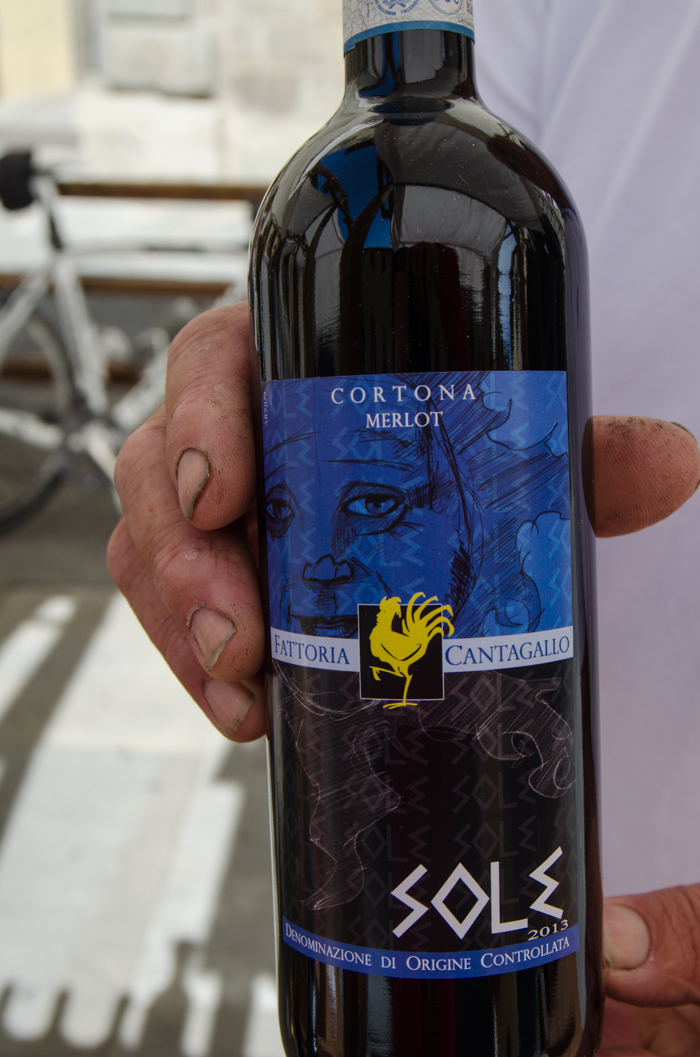 Cortona Rosso
Cortona Rosso
Syrah: between 50% to 60%, Merlot: 10% to 20%, with other local red grapes allowed by the DOC, up to a maximum of 30%. Ruby red, tending toward garnet with aging; elegant aroma, dry and harmonious.
Cortona Cabernet Sauvignon and Riserva
Cabernet Sauvignon: minimum 85%, with other local red grapes allowed by the DOC, up to a maximum of 15%. Ruby red tending to garnet; intense and characteristic spicy aroma; full bodied and elegant. Riserva wines undergo a miminim of 36 months of aging.
Cortona Merlot e Riserva
Merlot: minimum 85%, with other local red grapes allowed by the DOC, up to a maximum of 15%. Garnet with hints of purple; aromas of berries with grassy notes; dry, elegant and full bodied. Riserva wines undergo a miminim of 36 months of aging.
Cortona Sangiovese e Riserva
Sangiovese: minimum 85%, with other local red grapes allowed by the DOC, up to a maximum of 15%. Ruby red, tending to become red-orange with ageing; smooth and elegant nose; dry and harmonious. Riserva wines undergo a miminim of 36 months of aging.
Cortona Syrah e Riserva
Syrah: minimum 85%, with other local red grapes allowed by the DOC, up to a maximum of 15%. Ruby red to garnet; characteristic aroma; dry and well-balanced. Riserva wines undergo a miminim of 36 months of aging.
Dessert Wines: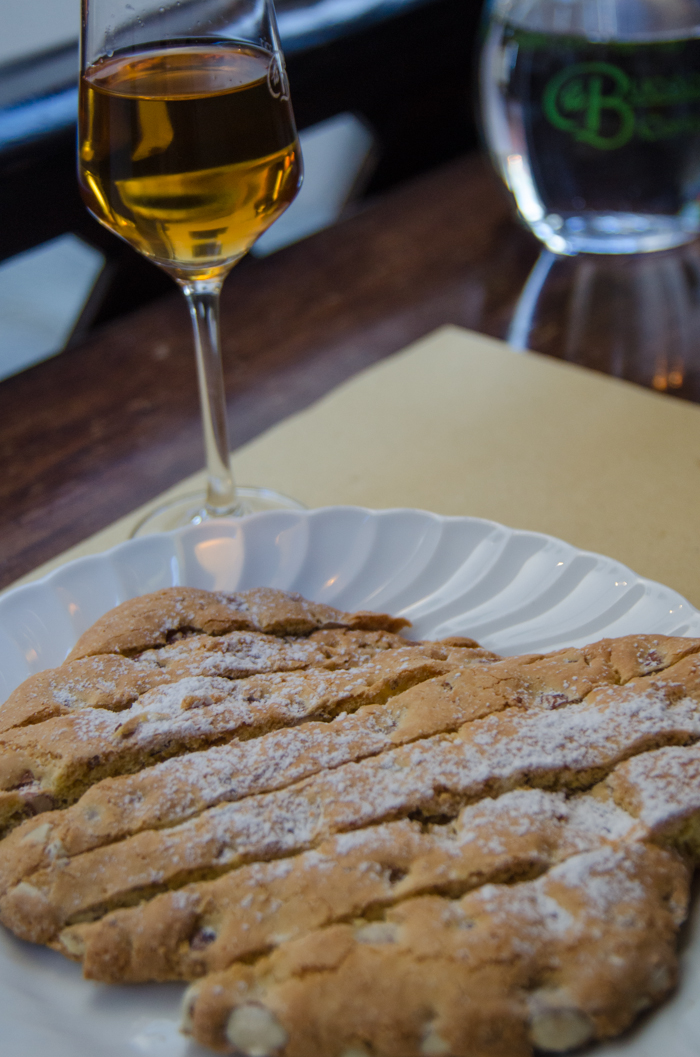 Cortona Vin Santo
Cortona Vin Santo
Trebbiano Toscano, Grechetto and Malvasia Bianca Lunga: jointly or alone, minimum 80%; with other local white grapes allowed by the DOC, up to a maximum of 20%. Color ranges from gold to amber; characteristic aromas of mature fruit; full, smooth and round.
Cortona Vin Santo Riserva
Trebbiano Toscano, Grechetto and Malvasia Bianca Lunga: jointly or alone, minimum 80%; with other local white grapes allowed by the DOC, up to a maximum of 20%. Gold to amber; characteristic aromas of mature fruit; full, smooth and round. Riserva wines undergo a minimum of 48 months of aging.
Cortona Vin Santo Occhio di Pernice
Sangiovese and/or Malvasia Nera, minimum 80%; with other local red grapes allowed by the DOC, up to a maximum of 20%. Amber to topaz, with a reddish shade that becomes brown with age; complex nose of ripe fruit; persistent with a sweet finish.
About 120km south of Florence, removed from the more industrialized areas in the north, is the prestigious wine zone of Montelcino. In 1980, Brunello di Montelcino was the very first wine zone in Italy to receive the exclusive DOCG (Denominazione di Origine Controllata e Garantita) quality designation.
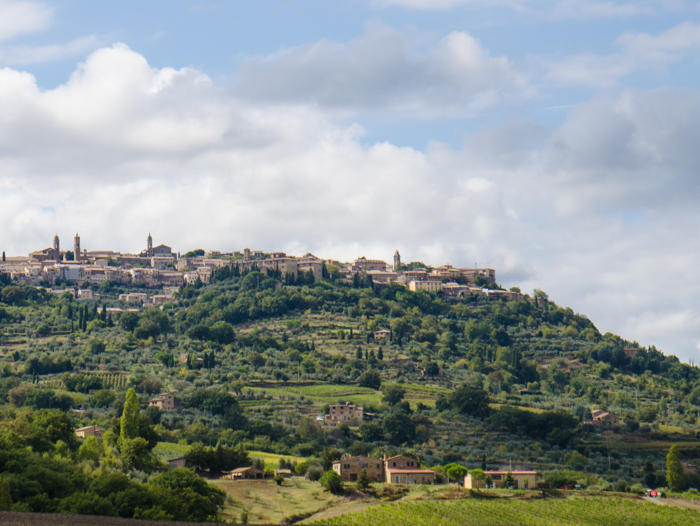
Montalcino is one of the driest and warmest wine zones in Tuscany, where the grapes mature up to a week earlier than in other areas. Much smaller in size than the Chianti, Montalcino still possess a wide range of soil types, from limestone to clay to volcanic. This diversity results in a range of flavors and characteristics, adding to the complexity of the resulting Brunello wines.
The word Brunello is the diminutive of bruno, brown in Italian, and was the vernacular name given to the favorite local grape. In 1879 testing eventually proved that the Brunello grape was actually a large-berried form of Sangiovese, Sangiovese Grosso, and officials designated that the name Sangiovese should be used.
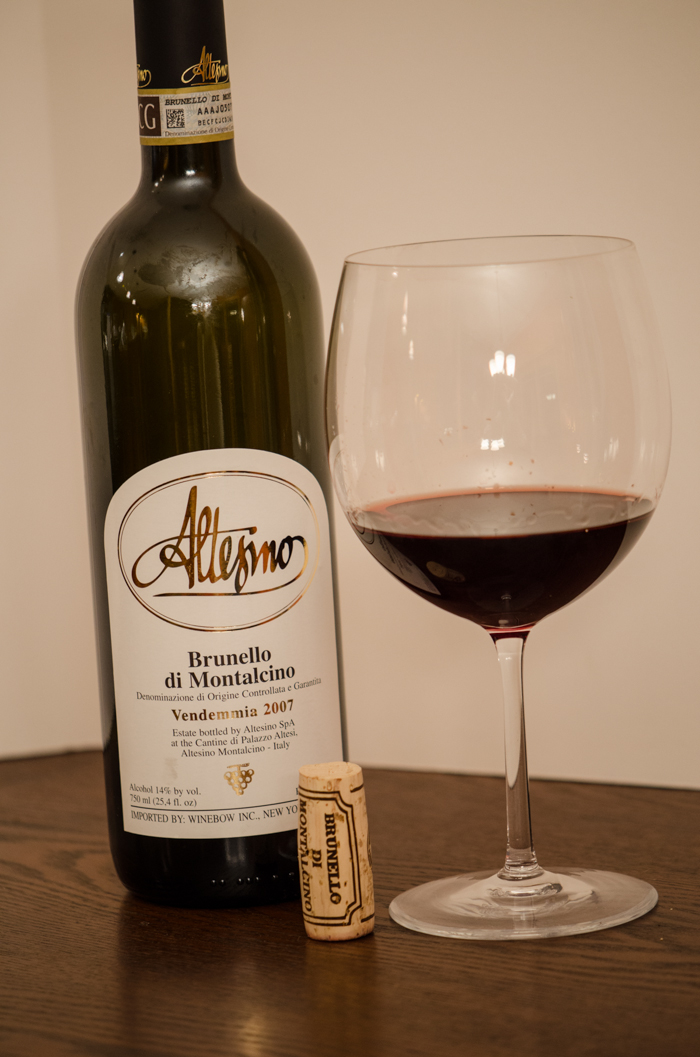
Evidence of red wine production in the Montalcino area dates back to the early 14th century. In the mid 1800s, records exists that mention Brunello wines as being prized particularly highly. These wines were a blend of Sangiovese and other grapes, which were all mixed together prior to fermentation. At this same time, a local farmer, Clemente Santi, began focusing on producing a 100% varietal wine, using only Sangiovese. His grandson, Ferruccio Biondi-Santi, a solider who fought under Garibaldi during the Risorgimento, returned home to take over the family business, and produced the first modern version of Brunello di Montalcino, aging it over a decade in wooden barrels.
By the end of World War II, Biondi-Santi’s Brunello di Montalcino wines had earned a reputation as a highly prized wine. At that time, Biondi-Santi was the only commercial producer, but as demand for these rare wines increased, other winemakers entered the market. Today, there are around 200 producers, mostly smaller farmers and family estates.
According to DOCG regulations, Brunello must be made from 100% Sangiovese grapes, and aged for at minimum four years, at least two of which must be in oak, and at least 4 months in the bottle before release. A minimum of five years aging is required for Riserva wines.
Brunello di Montalcino wines are typically a bright ruby red color, turning more garnet with age. It exhibits very pleasant aromas of dark berries, chocolate and tobacco, with notes of floral and vanilla. This is an elegant, full-bodied wine, very well structured with a nice amount of tannins, one that will age beautifully.
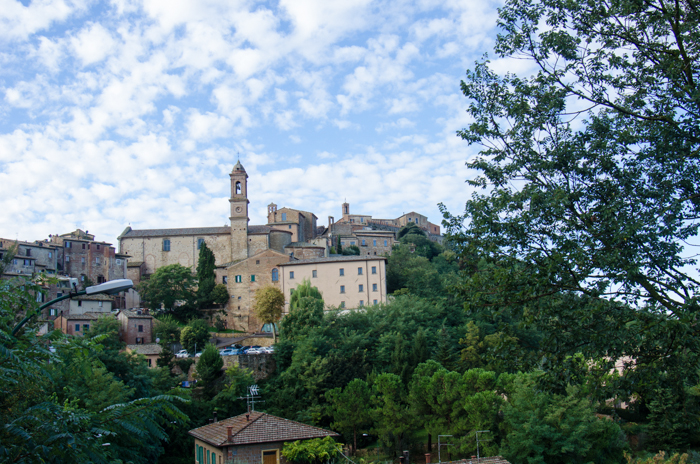
One of Italy’s more prestigious wine zones, and a stop on our Bike the Wine Roads of Tuscany tour, is Montepulciano. Vino Nobile di Montepulciano, the noble wine from Montepulciano, obtained DOCG (Denominazione di Origine Controllata e Garantita; Denomination of Controlled and Guaranteed Origin) status in 1980.
This wine is produced in the vineyards surrounding the town of Montepulciano, Italy, a small area in south-east Tuscany. The wine is made primarily from Sangiovese, which is known locally as Prugnolo gentile, blended with Canaiolo Nero and small amounts of other local varieties such as Mammolo. The wine is aged in oak barrels for 2 years; it earns riserva designation if it is aged for three years.
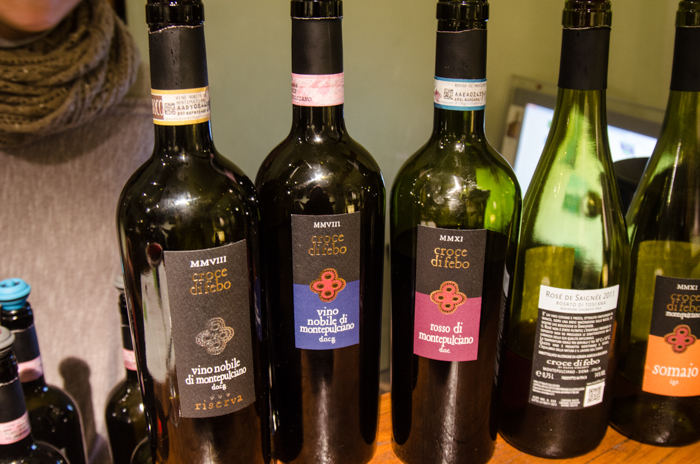
Montepulciano’s history has always been closely linked to wine. Legend claims that the town was founded by Etruscan king Lars Porsenna, who is said to have moved from Chiusi onto the ancient hill of Mons Mercurius. The people of Chiusi followed, and later changed the name of the hill to Mont Politicus. Remains from Etruscan tombs near Montepulciano included wine cups depicting the Etruscun god of wine, Flufluns.
A document dating back to 789 records the offer of a plot of farmland and a vineyard in Castello di Policiano to the to the Church of San Silvestro in Lanciniano. In the mid 14th century, there are official regulations for trade and exportation of wines from Montepulciano. During the late Middle Ages the wines from this region, back then referred to as Rosso Scelto di Montepulciano, enjoyed a prestigious reputation, found on the tables of nobles as far away as England to the popes in Rome.
The name Vino Nobile di Montepulciano was invented in 1930 by Adamo Fanetti. In 1925, Fanetti produced about 30 tons of this wine, which he called Nobile, and bottled and sold for two IT Lire a bottle. It was a great success at the first trade show of wine held in Siena in 1931, organized by Ente Mostra-Mercato Nazionale dei Vini Tipici e Pregiati. Mr. Tancredi Biondi-Santi, a friend and admirer of Fanetti, said prophetically: "this wine will have a future." Fanetti must be considered the first producer of Vino Nobile di Montepulciano. In the years following World War I and II, Cantine Fanetti promoted Vino Nobile di Montepulciano all over the world. Other companies, which produced mostly Chianti, followed Adamo's example and in 1937 founded the Cantina di Montepulciano cooperative, creating a structure for the marketing of wine produced by small local farmers.
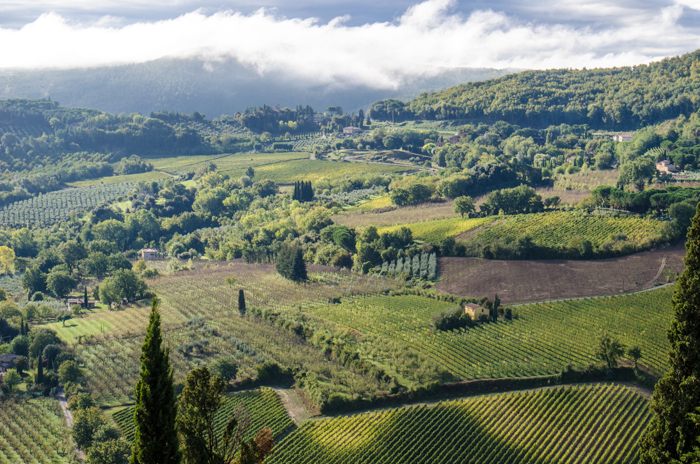
In the mid 1960s the DOC structure was created, and Vino Nobile received its DOC designation in 1966. The 1960s also brought a reawakening in winegrowing, and production moved towards Vino Nobile rather than Chianti. State and EU funds were used by the wineries to convert their vineyards into conformity with the requirements of the DOC (1966), enabled new wineries to enter the market.
Recognition of DOCG status came in 1980. In addition to this, the Rosso di Montepulciano DOC was created recognized red wines produced in the same region, where microclimates, exposure and altitude produce grapes that exhibit differenct characteristics. Along with a sweet vin santo, this small town continues its history as a wine producing center of the highest quality.
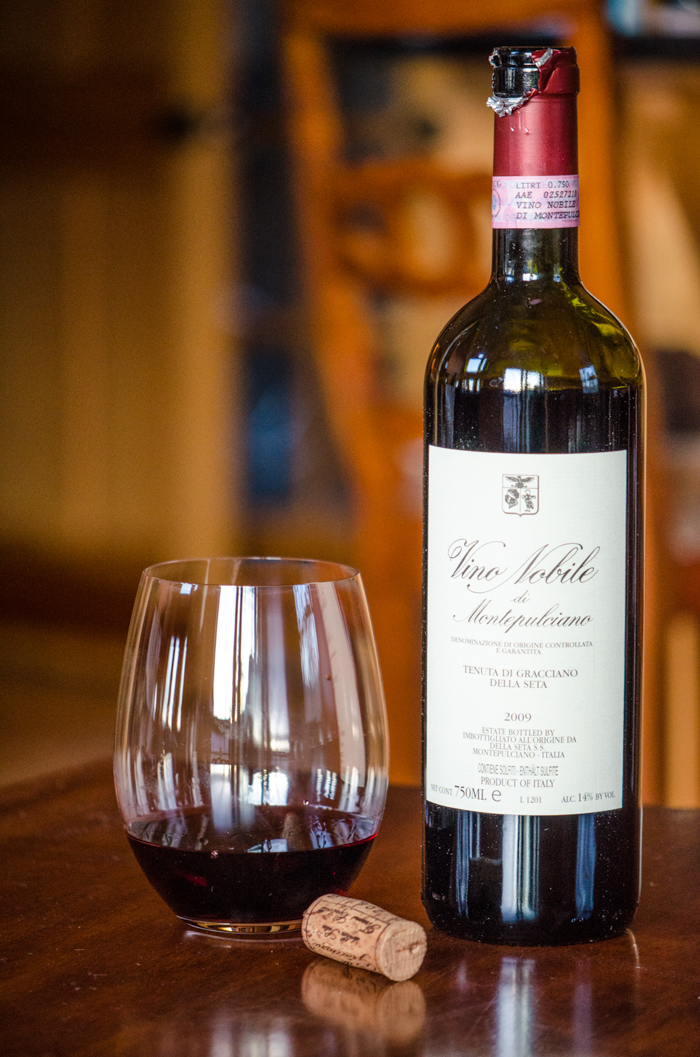
VINO NOBILE DI MONTEPULCIANO
On 12th July 1966, Vino Nobile di Montepulciano received its Denominazione di Origine Controllata (D.O.C.) designation. On 1st July 1980, Vino Nobile became the very first Italian wine to earn the Denominazione di Origine Controllata e Garantita (D.O.C.G.) which places it alongside the most prestigious wines in Italy and the world.
According to the current production regulations, the basic features of Vino Nobile di Montepulciano are as follows: A minimum of 70% Sangiovese, called Prugnolo Gentile in Montepulciano, blended with up to 30% of other varieties authorized for the Tuscany Region. The maximum permitted yield per hectare is 80 quintals with an effective yield in wine of 70%.
Vino Nobile wine can only be sold after aging for two years (three for the Riserva) and only after passing a series of tests carried out by a ministerial board. Vinification and ageing must take place in the municipal area of Montepulciano.
ROSSO DI MONTEPULCIANO D.O.C.
Rosso di Montepulciano DOC is a relatively young wine with distinctive quality features. The production zone and grapes used are identical to the Nobile. Its typical characteristics are the freshness of a youthful wine alongside the elegance of Prugnolo Gentile, making this wine excellent value for money and ideally served with local dishes. The Rosso di Montepulciano is a perfect accompaniment for traditional Tuscan first courses, and its features are especially enhanced by meat sauces as well as cured meats and local cheeses.
VIN SANTO DI MONTEPULCIANO D.O.C.
Vin Santo is a sweet wine with a long history of production in Tuscany. Once called the “wine of hospitality”, it was used to warm up a passing stranger on his way down from the hills, celebrate some happy event, or make a toast on a Sunday after a special meal.
There are three distinct designations for Vin Santo in this region: Vin Santo di Montepulciano, Vin Santo di Montepulciano – Riserva, Vin Santo di Montepulciano – Occhio di Pernice. The first two use Malvasia Bianca, Grechetto bianco (called “Pulcinculo” in Montepulciano), and Trebbiano toscano grapes. All must be grown in the province of Siena. The “Occhio di Pernice” has a different combination of varieties: a minimum of 50% Sangiovese with other varieties grown in the region
The traditional fermentation method is extremely typical for Vin Santo wines: the harvested grapes are selected and hung up to dry in temperature- and humidity-controlled rooms. Drying concentrates the sugars, makes it possible to obtain the sugar levels necessary to make the wine. According to the specifications, the grapes must be pressed from December 1 for Vin Santo di Montepulciano and January 1 for the other two, then aged in wooden barrels (caratelli) with a minimum capacity of 75 litres for the Occhio di Pernice and maximum of 300 litres (Vin Santo di Montepulciano). The ageing period lasts for at least 3 years for the Vin Santo di Montepulciano, 5 years for the Riserva and 6 for the Occhio di Pernice.
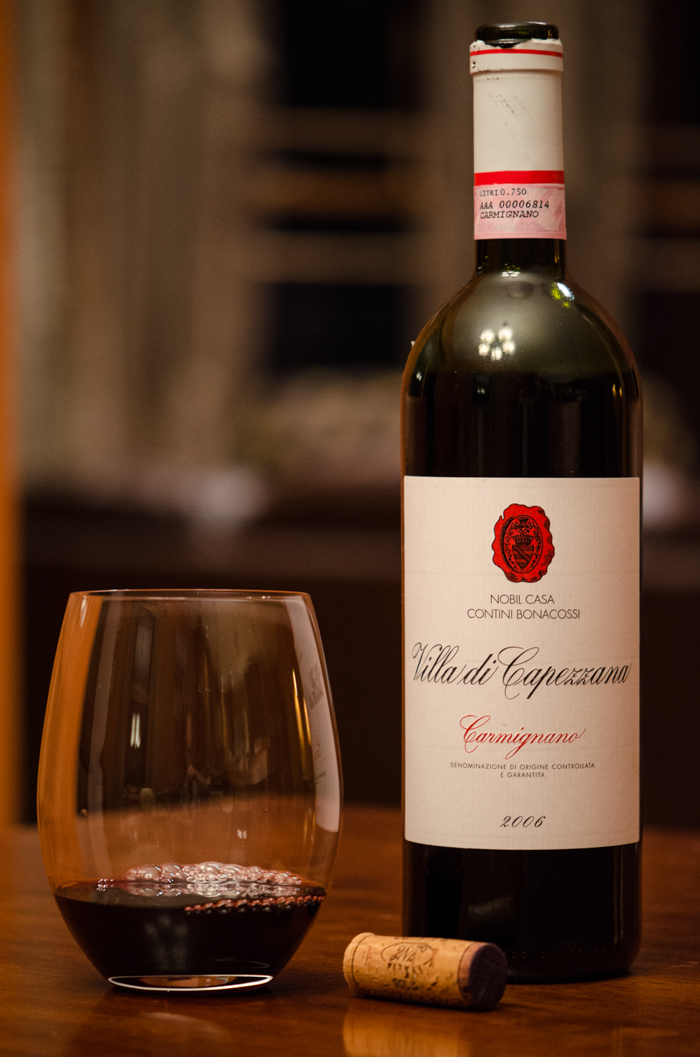
Carmignano is a very small but prestigious wine zone in Tuscany - one of the 6 DOCG zones in this region. Located in a valley about 16 km west and north of Florence, it is barely 100 hectares, and consists of only 20 producers in total. The leading producer in this appellation is Capezzano, an estate that is responsible for nearly 50% of this regions’ total production.
Etruscan artifacts demonstrate that wine was produced in this region as far back as 1000 B.C. In 1716, Cosimo deMedici III issued an edict that identified four distinct districts of Tuscany that produced the best wines. This was, in essence, the first attempt to identify wine ‘zones’, stipulating the areas in which the grapes must be cultivated, and forbidding the use of the names of these specific wines in any other area. One of the four regions was Carmignano.
After initially being lumped in to the Chianti wine zone when the modern day DOC regulations were developed, Carmignano earned its rightful place as its own DOC in 1975, and was then elevated to DOCG status in 1990.
The wines of Carmignano, like many Tuscan wine zones, are based primarily on the native Sangiovese. Here, however, a long tradition of cultivating Cabernet Franc and Cabernet Sauvignon in this region has lead to the inclusion of these two varietals in the production of the Carmignano wines, the first Tuscan wine to allow this. Local legend claims that Catherine deMedici was responsible for the introduction of these varietals in the region, but regardless, they flourish in the terroir of these hills.
The regulations for Carmignano DOCG specify the blend should contain a minimum of 50% Sangiovese, with up to 20% Canaiolo Nero and a maximum of 20% Cabernet Franc and/or Cabernet Sauvignon. Wines made from younger vines and declassified wine can be labelled as Barco Reale di Carmignano DOC.


